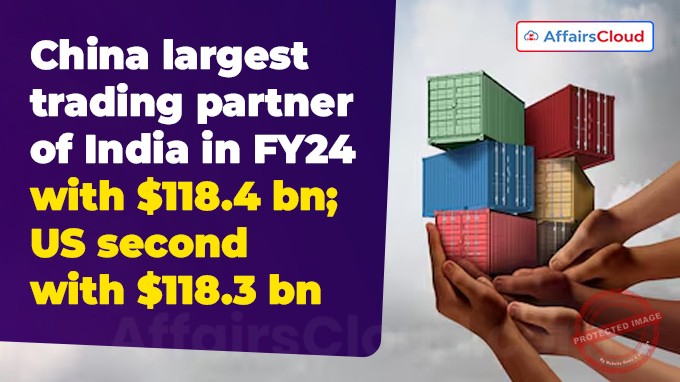 As per the data published by think tank Global Trade Research Initiative(GTRI), China emerged as the largest trading partner of India with USD 118.4 billion two way commerce in FY24 (2023-24). While, The United States of America(U.S.A.) with USD 118.3 billion was the 2nd largest trading partner of India in 2023-24.
As per the data published by think tank Global Trade Research Initiative(GTRI), China emerged as the largest trading partner of India with USD 118.4 billion two way commerce in FY24 (2023-24). While, The United States of America(U.S.A.) with USD 118.3 billion was the 2nd largest trading partner of India in 2023-24.
- For FY24, China replaced the U.S.A. to become India’s largest trading partner after a gap of 2 years. The U.S.A. was India’s top trading partner during FY22 and FY23.
Key Highlights:
India-China Bilateral Trade:
i.As per GTRI data, India’s exports to China increased by 8.7% to USD 16.67 billion in FY24 compared to FY23. It highlighted the main sectors which contributed towards the positive growth in exports such as: iron ore, cotton yarn/ fabrics, handlooms, spices, fruits and vegetables, among others.
ii.For FY24, India’s imports to China increased by 3.24% to USD101.7 billion. Data showed some critical products for India’s dependence on China are: telecom and Smartphone parts, advanced technology components, among others.
- The report showed that India imported telecom and Smartphone parts from China worth USD 4.2 billion, which is 44% of total imports in the telecom sector.
- Also, India imported Laptops and Personal Computers(PCs) from China worth USD 3.8 billion, which is 77% of India’s import in this sector.
iii.India is heavily dependent on China’s Lithium(Li) which is critical for electrification of transport sector in India.
- India imported USD2.2 billion of Lithium from China which is 75% of India’s imports in this sector.
iv.The GTRI report mentioned that India’s trade deficit with China increased from USD 53.57 billion(FY19) to USD 85.09 billion (FY24).
- This widened trade deficit for India is due to the stagnant growth of India’s exports to China, which remained same between FY19 and FY24.
- India’s exports to China between FY19 and FY24 saw a marginal decline in exports by 0.6%, decreased from USD 16.75 billion to USD 16.66 billion.
- While, imports from China increased by 44.7%, increased from USD 70.32 billion to USD 101.75 billion.
India-U.S. Bilateral Trade:
i.India-U.S. bilateral trade stood at USD 118.3 billion in 2023-24. The report showed India’s export to U.S. decreased by 1.32% to USD 77.5 billion in FY24 compared to FY23. Whereas, imports also decreased by 20% to USD 40.8 billion.
ii.Between FY19 and FY24, trade with the U.S. showed a positive growth, with India’s exports to U.S. increased exponentially by 47.9% from USD 52.41 billion to USD 77.52 billion.
- Simultaneously, Imports from U.S. increased by 14.7%, from USD 35.55 billion to USD 40.78 billion. This resulted in an expanded trade surplus for India which increased from USD 16.86 billion to USD 36.74 billion.
India’s trade with other countries:
i.As per GTRI report, The United Arab Emirates (U.A.E.) with USD 83.6 billion, was the 3rd largest trading partner of India in FY24, then followed by Russia(USD 65.7 billion), Saudi Arabia (USD 43.4 billion), and Singapore (USD 35.6 billion).
ii.India’s bilateral trade with following countries between FY19 and FY24:
- India’ s exports to UAE increased by 18.3% from USD 30.13 billion to USD 35.63 billion, and imports increased significantly by 61.2% from USD 29.79 billion to USD 48.02 billion. This showed a marginal trade surplus of USD 30.34 billion(FY19) into a deficit of USD 12.39 billion by FY24.
- As per the report, during last 5 years, India’ s exports to Russia increased significantly by 78.3% from USD 2.39 billion to USD 4.26 billion, while imports surged by 952% from USD 5.84 billion to USD 61.44 billion, widening trade deficit from USD 3.45 billion to USD 57.18 billion.
- India’ s exports to Saudi Arabia increased by 107.9% from USD 5.56 billion to USD 11.56 billion. While, imports increased marginally by 11.7% from USD 28.48 billion to USD 31.81 billion which slightly reduced the trade deficit from USD 22.92 billion to USD 20.25 billion.
About Global Trade Research Initiative(GTRI):
GTRI’s mission is to produce high quality jargon free outputs for governments and industry on trade, technology and investment issues from the standpoint of development and poverty reduction.
Co-founder: Ajay Srivastava




